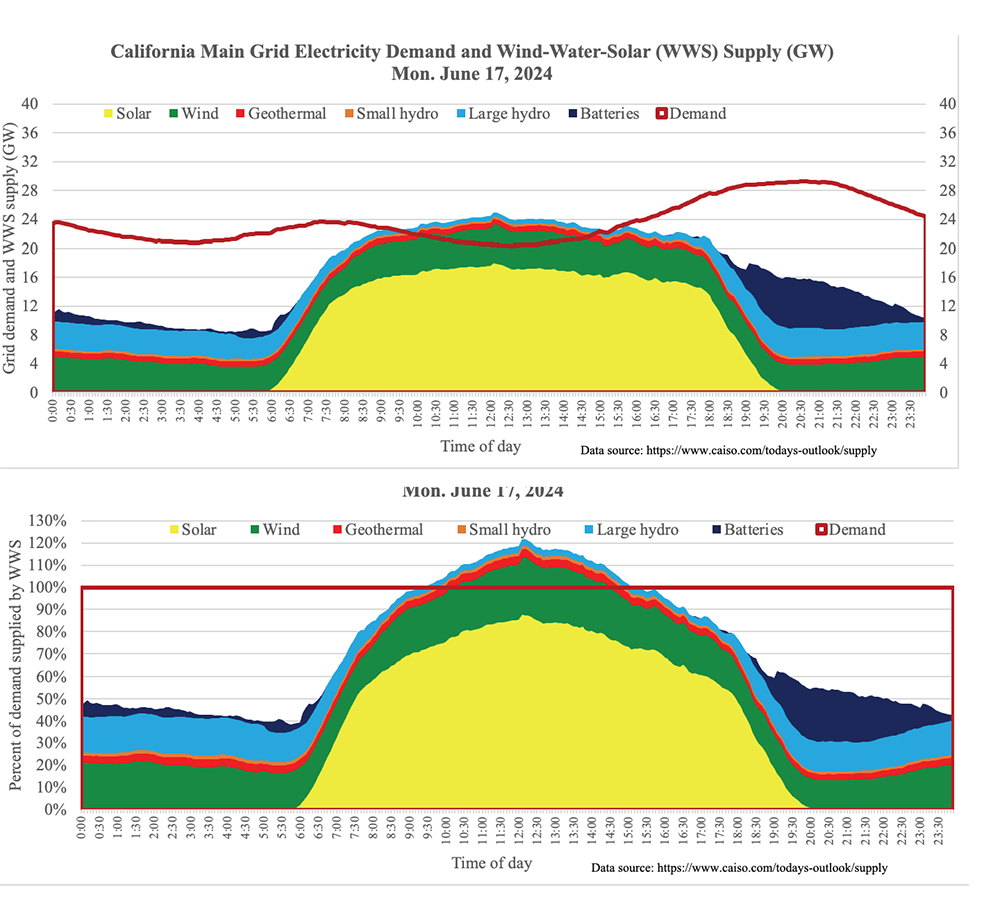No rolling blackouts or grid emergencies as California continues on path to a carbon free grid. Several strategies, including upgrades to vulnerable parts of the grid at play here, but key enabler is more clean energy, especially solar, and above all, battery storage, now equivalent to 5 very large nuclear power plants.
Love to see those batteries paying off immediately. Also didn’t realize it made California a net power exporter during peak hours.
Compare that to Texas, with a similar renewable energy makeup, whose go-it-alone grid works great unless it’s too hot or too cold or too stormy in the case of Beryl.
Just know, hurricanes aren’t just stormy, they have what’s known as a storm surge. The lower pressure effectively sucks the water up multiple feet, causing a rise in sea level. So you now have a body of water with a whole new height moving toward and over everything.
Kind of how a tsunami isn’t just a little extra water moving inland, it’s a whole section of the ocean being displaced…and with the path of least resistance being over land (because air is compressible, while water is significantly more difficult to compress), you’re gonna have a bad time.
I was here for it - Beryl took out the whole city, even the parts far, far away from the effects of the storm surge. One would expect chaos on the coast, but not inland. 70-90mph gusts are common enough (multiple times per year) that the grid should be resilient to them, but it simply isn’t. Blatant infrastructure mismanagement.
My family’s there too, and I grew up there, and I couldn’t disagree more. “70-90mph gusts” cause serious damage to trees, homes, and power lines, but they’re highly localized, and so the damage is easy to repair. Houston just experienced 60-70mph sustained winds with gusts up to 90 and a number of tornadoes across the entire metro for like 2+ hours, which caused destruction several orders of magnitude greater than what you’re comparing it to. All that is to say Centerpoint Energy definitely got caught with their pants down, which had the outage dragging on for a lot of their customers
No doubt it should be considered extreme weather. But since things like this happen with regularity, the infrastructure should be engineered to handle it.
It’s likely cheaper for them to ignore the problem, however.
There is no place on the planet that is hurricane proof. They’re the most power thing on planet earth. Texas is infrastructurally in the dark ages but California would be left in the dark too if a catogory 1 or 2 made direct landfall. And I say this as someone who’s lived in the mid Atlantic
Climate change could change things, but California’s history of hurricanes is pretty okay. Better than Texas, anyway.
https://en.m.wikipedia.org/wiki/List_of_California_hurricanes
In recorded history, California’s only had one hurricane to ever make landfall, in 1858
Many places on Earth are hurricane proof. They’re mostly in the South Pacific where the US military built most of the infrastructure.
Have you ever heard of Guam being fucked up by a hurricane? No, because all the buildings are concrete blocks. They just close the storm shutters. Here’s a Cat 4 that directly hit the island with no deaths and no significant injuries:
https://www.cnn.com/2023/05/25/weather/guam-typhoon-mawar-damage-thursday/index.html
Guam is not hurricane proof.
Typhoon Mawar
Despite being the strongest storm to strike the island in over 20 years, overall structural damage was relatively limited. However, the typhoon’s powerful winds did defoliate and uproot trees, topple billboards, and tear tin roofing from buildings. Floodwaters in Yona were reported to be waist-deep. Guam Memorial Hospital suffered some damage as typhoon shutters gave out, walls collapsed, and windows broke. Torrential rains pouring through damaged areas of the building caused staircases to flood with water. The hospital’s kitchen caught fire during the storm, leaving it useless.[88] Four piers operated by Mobil were damaged at the Port of Guam. Along Piti Channel, three barges, two mobile crane barges, and a derelict vessel were grounded. Two tugboats sank during the storm, forcing crew members to abandon ship. A dry dock at Cabras Island sank. The Sumay Cove Marina at Naval Base Guam suffered damage. Navy Rescue 21 Search and Rescue towers were rendered inoperable
President Joe Biden declared Guam a major disaster area on May 27, enabling the distribution of federal funds. A total of 150 Federal Emergency Management Agency (FEMA) personnel were on the island by this point. Guam Delegate James Moylan penned a request to FEMA for the distribution of supplies from a warehouse containing over 1 million units of water and 900,000 meals.
Damages from Mawar to businesses were estimated to be US$111.8 million, The Guam Memorial Hospital’s reported damages were at least US$12 million, and The Port Authority of Guam has estimated US$8.2 million in damages, excluding the assessments of fuel piers. A prison in Guam sustained US$2 million.
So you’re saying they’re too stormy.
And surge-y
I know it’s in vogue to criticize “the Texas grid,” but there was only one incident that involved the actual grid supply and demand, which was the snowstorm in 2021. The only other outages that have happened were localized outages due to mechanical damage to power lines, eg from ice or hurricane-force winds. How long it’s taken Centerpoint Energy to get all those lines back up is certainly something to criticize, but it also has nothing to do with the Texas grid." And there have been no rolling blackouts due to heat, despite the implication in that Vice headline
I’m a little annoyed that my client apparently didn’t show me this post yesterday.
I’m nominally familiar with utility scale issues and it appears the fault here lie with the lack of regulatory environment in Texas.
There’s a process called “Line Clearing” where utilities send crews to cut down branches or sometimes whole trees if they pose a risk to power lines. Line clearing mostly impacts local circuits. Circuits are neighborhood level, and those power lines are lower than other kinds of power lines. Schedules for line clearing are often set with regulatory bodies, but can be left to utilities to set.Because line clearing means that crews have to traverse every power line on the grid, it’s often not something that utilities want to do. If given a say in the regulatory process or left to their own devices, they’ll opt for as long of a span between line clearings as possible.
What’s that mean, now that I’ve written so much? Well, it means that when big storms come through, the failure point isn’t necessarily the transmission lines or the power stations. It’s the local lines, disconnecting individual houses, streets, or entire neighborhoods. Instead of a few fixes here and there to get the grid back up, it’s a lot of fixes everywhere, which is time consuming and expensive. It means that ‘everyday’ failures are more common as trees can rot out and randomly collapse.
And, sure - those everyday fixes are relatively easy to deal with individually, but in a situation where a lot of those issues accumulate at once, they can cause other, more serious issues on the grid, as well as creating a massive backlog to work through.It’s sort of a foundational regulatory problem that seems to not have been addressed. A lot of midwestern states can bear wind storms with minimal problems - because their grid standards are written with lots of wet snow in mind.
Which is all to say, it’s supply, demand, delivery, and all the trappings therein, too.
I think on those grounds, criticism of Texas’ grid stands.deleted by creator
Don’t get me wrong I’m happy about the batteries but tbf there have still been shutdowns. Let’s not make this sound prettier than it is. Also PG&E is fucking price gouging us. If they are saying the grid is a net exporter then shit should be cheaper.
100 days of 100% renewable then shows an image where demand is in excess of renewables.
30% renewable power is really not a lot at all. If that’s the best America can do in the best state. That’s really shocking. Richest country in the world with some of the best solar and wind resources of any country and they are trying to make out 30% is a good figure.
30% isn’t “The best we can do.” it’s the best we’ve done so far. Nearly every State in the U.S. is busy building out Wind and Solar capacity and that isn’t going to stop, the number is going to keep climbing.
The real news in this article is how well the battery piles are doing at keeping the grid stable while meeting demand spikes. It’s real world data showing that the base load problem can be mitigated, or even eliminated, if you have sufficient energy storage.
It absolutely is the best you can do in 2024. Future goals don’t help with now. America should be way further along. Behind both Europe and China in a lot of ways.
The present and the future are two separate issues. But even then future plans seem lower than what they should be.
The battery and grid usage is a good sign for things to come. There was a much better article on this from a few months though. China has done a real impressive job with dropping the battery prices worldwide.
Are you misreading something? According to the graphs, renewables generated 120% of demand during the day and still around 50% at night with no solar
I get what they are trying to say but it doesn’t read like that.
Texas

Conservative media: LIBERAL California electricity only works because they’re having immigrants steal your energy! Go green, go immigrant violence! Windmills cause transgenderism!




